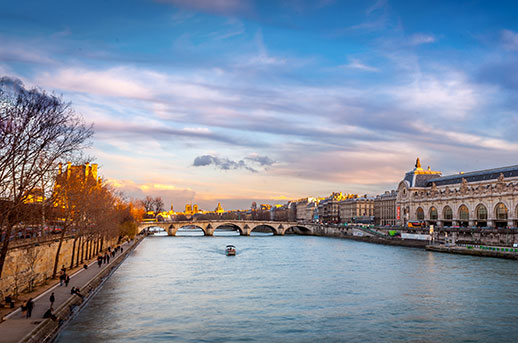


As travellers, we are increasingly seeking to experience the destinations we visit through the eyes, ears and even stomachs of the locals. Paris is a destination that richly rewards the intrepid traveller who is happy to cast aside the guide book and wander through its broad avenues and narrow streets. With a little basic knowledge and a willingness to follow your eyes and nose, you too can pass yourself off, if not quite as a local, at the very least like a seasoned visitor.
Firstly, here are a few pointers about the layout of the city. You will hear Parisians speak of arrondissiments, which is the name given to the twenty boroughs that make up the city. The first arrondissiment is one of the oldest parts of the city, taking in part of the Île de le Cité and the Louvre. From there the arrondissiments spiral in a clockwise direction. If you can master their approximate layout, you’re off to a flying start.
The other major geographical points of reference are the Rive Gauche and Rive Droite (Left and Right Banks). The Left Bank refers to the southern side of the Seine and is traditionally the more bohemian, creative part of the city, and includes such landmarks as the Musée d’Orsay and the famed eatery, the Café de Flore. By contrast, the Right Bank is the elegant, sophisticated side, home to grand avenues like the Champs-Elysées and impressive landmarks like the Louvre.
Now that we’ve mastered these basic tenets of Parisian town planning, we can move on to some authentic Parisian experiences:
Paris is a walker’s delight. The Berges de Seine is a walkway constructed on what was once a highway that follows the Left Bank of the Seine for a little more than two kilometres. It’s now a tree lined promenade that includes five floating gardens, and it’s a great place to stroll and people-watch. Another unusual walkway is the Coulée Verte René Dumont, also known as the Promenade Plantée. This walkway is constructed along a disused railway track, starting at the Bastille and continuing for three miles along a tree lined route. It is now home to a enticing mix of shops and galleries
All that walking has to be balanced with some down time, and the best place to do so is in one of Paris’s beautiful and famous parks. At the end of the Avenue des Champs-Elysées, tucked neatly between the Place de la Concorde and the Louvre, you’ll find a haven of tranquillity in the Tuileries Garden. It’s a favourite spot for Parisians and tourists alike to sit and enjoy the water features and carousels. Another place to wind down is the Luxembourg Gardens. If it wasn’t for Marie de Medici and her homesickness for Florence, these gardens would no exist.
Anyone who hankers to experience France like a local must visit at least one market, and Paris has some wonderful options. The Rue Mouffetard is one of the best food markets in Paris, and is located on the Left Bank in the bustling Fifth Arrondissiment. As well as the dozens of market stalls selling fresh produce every morning at the southern end of the street, you’ll also find many of the shops that line the street have open air frontages. Another option is the famed Marché au Fleurs, which is located on the Île de la Cité. Dedicated solely to flowers, shrubs and trees, it’s no wonder that the colours and scents acts as a lure to arty types seeking inspiration.
No self-respecting Parisian would discount the importance of great food when it comes to understanding what makes this great city tick. If you can combine your dining experience with a fabulous view of the city, like at The Restaurant-Café Georges, located atop the world-famous Pompidou Centre modern art museum, you will have the full Parisian experience.
Another rooftop dining experience that’s not to be missed is Le Déli-cieux atop the famous department store, Printemps. Serving fresh, café-style food and yummy pastries until at least 8pm every night , you can enjoy a few happy hours’ shopping in its hallowed halls before heading up to the ninth floor to take in the lights of Paris while you refuel with a café au lait.
During summer, a series of five beaches known as Paris Plages appear each year along the banks of the Seine. You wouldn’t want to actually swim in the river itself, but with features like real sandy beaches, deck chairs and even floating swimming pools on the Seine, they can be a great way to pretend that you’ve actually gone to the south of France for your summer holiday too.
Another benefit of finding yourself in Paris during the summer months is the many open-air cinemas that appear in the city’s parks. One of the most well-known and much-loved is at Paris’ third largest park, the Parc de la Villette in the 19th arrondissiment. It shows everything from classic French farce to Hollywood blockbusters (in French, of course), so pack up a picnic and prepare to spend a balmy evening out.
Now that we’ve covered the basics, it’s time to talk to your personal travel manager about finding the perfect home base. Whether you prefer the bohemian feel of the Left Bank or something grander across the river; whether you’re after a small, family-run hotel or the convenient facilities of an apartment, we can help you find your ideal Parisian home away from home.